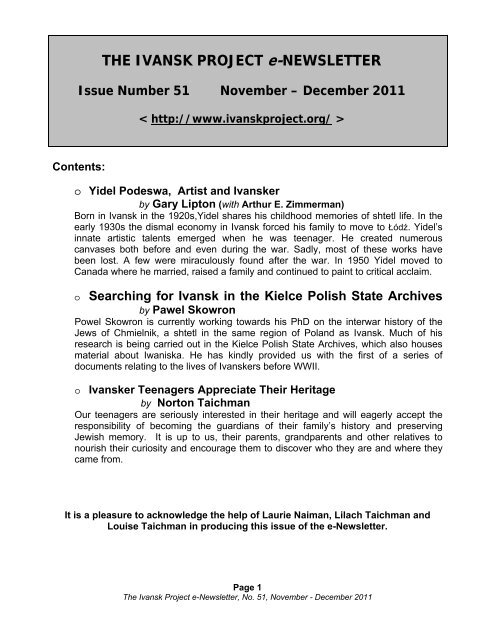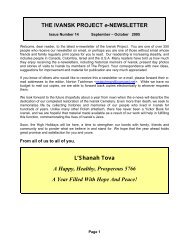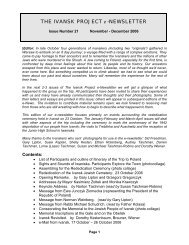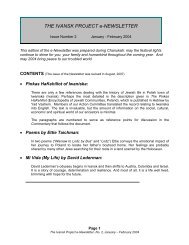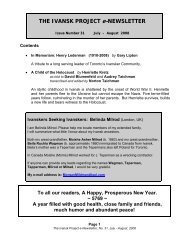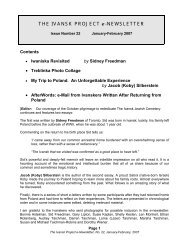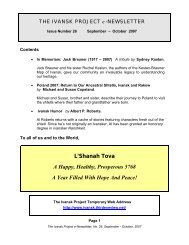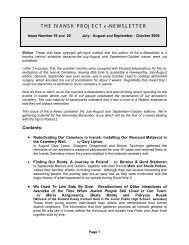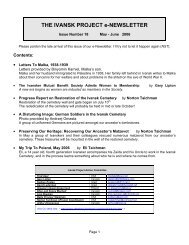51 - Ivansk: Our Jewish Heritage in Poland
51 - Ivansk: Our Jewish Heritage in Poland
51 - Ivansk: Our Jewish Heritage in Poland
- No tags were found...
You also want an ePaper? Increase the reach of your titles
YUMPU automatically turns print PDFs into web optimized ePapers that Google loves.
THE IVANSK PROJECT e-NEWSLETTERIssue Number <strong>51</strong> November – December 2011< http://www.ivanskproject.org/ >Contents:o Yidel Podeswa, Artist and <strong>Ivansk</strong>erby Gary Lipton (with Arthur E. Zimmerman)Born <strong>in</strong> <strong>Ivansk</strong> <strong>in</strong> the 1920s,Yidel shares his childhood memories of shtetl life. In theearly 1930s the dismal economy <strong>in</strong> <strong>Ivansk</strong> forced his family to move to Łódź. Yidel’s<strong>in</strong>nate artistic talents emerged when he was teenager. He created numerouscanvases both before and even dur<strong>in</strong>g the war. Sadly, most of these works havebeen lost. A few were miraculously found after the war. In 1950 Yidel moved toCanada where he married, raised a family and cont<strong>in</strong>ued to pa<strong>in</strong>t to critical acclaim.o Search<strong>in</strong>g for <strong>Ivansk</strong> <strong>in</strong> the Kielce Polish State Archivesby Pawel SkowronPowel Skowron is currently work<strong>in</strong>g towards his PhD on the <strong>in</strong>terwar history of theJews of Chmielnik, a shtetl <strong>in</strong> the same region of <strong>Poland</strong> as <strong>Ivansk</strong>. Much of hisresearch is be<strong>in</strong>g carried out <strong>in</strong> the Kielce Polish State Archives, which also housesmaterial about Iwaniska. He has k<strong>in</strong>dly provided us with the first of a series ofdocuments relat<strong>in</strong>g to the lives of <strong>Ivansk</strong>ers before WWII.o <strong>Ivansk</strong>er Teenagers Appreciate Their <strong>Heritage</strong>by Norton Taichman<strong>Our</strong> teenagers are seriously <strong>in</strong>terested <strong>in</strong> their heritage and will eagerly accept theresponsibility of becom<strong>in</strong>g the guardians of their family’s history and preserv<strong>in</strong>g<strong>Jewish</strong> memory. It is up to us, their parents, grandparents and other relatives tonourish their curiosity and encourage them to discover who they are and where theycame from.It is a pleasure to acknowledge the help of Laurie Naiman, Lilach Taichman andLouise Taichman <strong>in</strong> produc<strong>in</strong>g this issue of the e-Newsletter.Page 1The <strong>Ivansk</strong> Project e-Newsletter, No. <strong>51</strong>, November - December 2011
Yidel Podeswa, Artist and <strong>Ivansk</strong>erby Gary Lipton (with Arthur E. Zimmerman ), Toronto, CanadaOn June 30, 2004, Arthur Zimmerman and I met with Yidel Podeswa and his wife Ruth at theirhome <strong>in</strong> Toronto. We were there to obta<strong>in</strong> Yidel’s childhood memories of <strong>Ivansk</strong>. Bonnie Gouldaccompanied me for a second meet<strong>in</strong>g with Yidel and Ruth <strong>in</strong> the summer of 2007.Yidel and Ruth Podeswa- At Home -Toronto, 2007The purpose of the <strong>in</strong>terviews was to have Yidel shed light on daily life <strong>in</strong> <strong>Ivansk</strong> dur<strong>in</strong>g the 1920’sand the 1930’s. It was not our primary <strong>in</strong>tent to learn about his Holocaust experiences. That story isboth personal and sensitive and would fill a large volume. Rather, we hoped that Yidel wouldprovide <strong>in</strong>formation on the personal lives of his family and shed light on the rhythm of life <strong>in</strong> theshtetl.It is important to understand that Yidel’s memories of <strong>Ivansk</strong> are fragmentary. His family moved toŁódź sometime <strong>in</strong> the mid 1930’s when he was perhaps 10-12 years old. His memory may havebeen affected by poverty and hunger that he endured as a youth. As well, the loss of his entirefamily <strong>in</strong> the Holocaust meant that he missed opportunities to rem<strong>in</strong>isce about his childhood withparents, sibl<strong>in</strong>gs, cous<strong>in</strong>s, or even neighbours. Dur<strong>in</strong>g our conversations Yidel expressed himself<strong>in</strong> short, poignant statements, careful to say exactly what he recalled. Perhaps there is someth<strong>in</strong>gof the artist <strong>in</strong> both his memories and his precise manner of expression. In the story that followsYidel’s narrative is presented <strong>in</strong> italics. Serv<strong>in</strong>g as editor, I provided commentary and other<strong>in</strong>formation that appear <strong>in</strong> standard font.The Early YearsI was born and raised <strong>in</strong> <strong>Ivansk</strong> 1 . My earliest memories were of grow<strong>in</strong>g up very poor but hav<strong>in</strong>g ahappy childhood with a lov<strong>in</strong>g family. <strong>Ivansk</strong> was not a bad place, just very poor. My immediate1 The exact date of Yidel’s birth is not known. Accord<strong>in</strong>g to records from Dachau concentration camp whereYidel was liberated at the end of the war, he was born on December 10, 1924..Page 2The <strong>Ivansk</strong> Project e-Newsletter, No. <strong>51</strong>, November - December 2011
family consisted of my mother and father, Devorah Laufer and Chaim Podeszwa, my two brothers,Meyer (Melech) and Alter, and my five sisters, Malka, Gittel, Temma, Tzirel and Pessel. We livedtogether <strong>in</strong> the home of my mother’s father, Yankel Laufer and his second wife Sorel 2 . My father’sparents, Yuma (Benyam<strong>in</strong>) and Pessel Podeszwa lived next door along with my father’s sisters,Tzirel and Faiga.<strong>Our</strong> home was very modest. My grandparents lived on the ma<strong>in</strong> floor and my entire family had theupstairs. Ra<strong>in</strong> came <strong>in</strong> from the leaky roof. The house was without electricity or runn<strong>in</strong>g water andhad no separate kitchen. A cast iron wood-burn<strong>in</strong>g stove served for cook<strong>in</strong>g and heat<strong>in</strong>g, a tablefor eat<strong>in</strong>g and work<strong>in</strong>g, and beds were placed around the walls. Light was provided by a kerosenelamp. The house was made of bricks, and the walls were periodically pa<strong>in</strong>ted with lime whitewash.Some <strong>Jewish</strong> homes had their own outhouse facilities. <strong>Our</strong> family shared the outhouse at the backof Zaida Yankel Laufer’s house.<strong>Ivansk</strong>: Yankel Laufer (seated)Yankel was Yidel’s maternal grandfather.He is surrounded by other familymembers.We were very poor. My father earned a meager <strong>in</strong>comewhite-wash<strong>in</strong>g homes, especially before Pesach. Foodwas scarce. My mother baked bread about every twoweeks. We could have eaten it all <strong>in</strong> one day, but it had tolast until my mother baked aga<strong>in</strong>. Local farmers providedapples and pears, as well as milk and cheese. Meat wasreserved for very special occasions.Water for dr<strong>in</strong>k<strong>in</strong>g and cook<strong>in</strong>g was brought from a well.The Podeszwa and Laufer homes were located only afew steps away from a well on the road lead<strong>in</strong>g out oftown to Staszów (see Kesten-Brauner (K-B) map).[<strong>Ivansk</strong> had at least 2 additional wells, perhaps more.]Laundry was was taken by the women of the family upthe road to Apt (Opatów), past the church to the river(Koprzywianka), where people also washed themselves.A branch of the river ran to the mikve. A trip to the mikveon Friday was a weekly ritual.Food and other necessities were obta<strong>in</strong>ed from smallgrocery stores on the street or border<strong>in</strong>g the centralmarket square (the “Rynek”; see the K-B map). <strong>Jewish</strong>merchants owned most stores and shops (which alsoserved as dwell<strong>in</strong>gs). The center of the square was anopen common area. Mondays were market days.Farmers came with horse-drawn wagons and sold theirproduce from the back of their wagons. The farmers wereall Gentiles. Portable stalls and displays were set up by townsfolk and peddlers who offered avariety of goods for sale. My grandfather, Zaida Yuma and his two daughters, Fayge and Tzirel,sewed shirts and sold them at the market.2 The homes of the Laufer and Podeszwa families are #56 and #57 <strong>in</strong> the “Kesten-Brauner (K-B) Map of<strong>Ivansk</strong>”. The map can be viewed on our web site:http://www.ivanskproject.org/Photos/<strong>Ivansk</strong>_mapKB.htmlYidel’s father, Chaim, literally married the girl next door. Yidel recalled that his paternal grandfather, YumaPodeswa, visited Toronto many times before the war. Apparently, “He could imitate any <strong>in</strong>strument with hismouth and was <strong>in</strong>vited to enterta<strong>in</strong> at wedd<strong>in</strong>gs.”Page 3The <strong>Ivansk</strong> Project e-Newsletter, No. <strong>51</strong>, November - December 2011
I went to Polish school dur<strong>in</strong>g the day. Afterwards, I studied religious subjects at the house of themelamed. I remember two rabbis: a young <strong>Ivansk</strong>er rabbi 3 , as well as the Shedlover rabbi whooften visited the town 4 . Every Friday as Shabbos approached the “Shabbos Klapper” walkedthrough <strong>Ivansk</strong> knock<strong>in</strong>g on the door of every <strong>Jewish</strong> home. On Shabbos I got dressed up andwore a sat<strong>in</strong> hat. The men went to shul. I recall pa<strong>in</strong>t<strong>in</strong>gs on the walls of the shul. These memoriesof Shabbos are good memories. The women did not go to shul with us. No doubt they were athome prepar<strong>in</strong>g the Shabbat meal.Art as a Family TraditionPa<strong>in</strong>t<strong>in</strong>g was a Podeswa family tradition. Yidel’s father, not only pa<strong>in</strong>ted houses but was an artistas well. My father never saw a picture <strong>in</strong> his life. The only pictures he ever saw, besides thepa<strong>in</strong>t<strong>in</strong>gs on the walls of the <strong>Ivansk</strong> shul, were on paper candy wrappers.Due to amaz<strong>in</strong>g circumstances two of Yidel’sfather’s pa<strong>in</strong>t<strong>in</strong>gs have survived. In 1935 bothwere rolled and mailed to Surah Temma,Yidel’s aunt who lived <strong>in</strong> Toronto.Life <strong>in</strong> <strong>Ivansk</strong> <strong>in</strong> the 1930’s was difficult. Mostpeople, Jews and Gentiles, were very poor.And yet there was a spiritual richness. Aschildren we played with nuts. We would rollmetal r<strong>in</strong>gs with sticks about the town. I recallthat there were many <strong>Jewish</strong> movementsactive <strong>in</strong> <strong>Ivansk</strong>. As a religious family we didnot participate <strong>in</strong> the Zion<strong>in</strong>st movement.The Gravesite. by Chaim PodeszwaOne of the two oil pa<strong>in</strong>t<strong>in</strong>gs that Yidel’s father sent toCanada <strong>in</strong> 1935 is shown (oil on canvas; 18” x 25”)An English translaton of the Hebrew <strong>in</strong>scription on thematzevah reads:Because of this, I cryFor my mother, my teacherMolly, daughter of KalmanWho died on the second dayOf Chol Hamoed Pesach5763 [1913]The matzevah sits on a stone wall guarded by twoconical pillars and a Polish eagle. A blue vessel (withflower) and a peacock are seen on either side. Thera<strong>in</strong>bow represents a traditional symbol of hope for thefuture.I was not the only member of my family whobecame an artist. My elder brother Melechwas a great pa<strong>in</strong>ter. He moved to Lodz wherehe and his friend Tvilich studied <strong>in</strong> the studioof a Bulgarian artist named Bengoli whotaught them to pa<strong>in</strong>t with a palette knife.Melech created hundreds of pa<strong>in</strong>t<strong>in</strong>gs <strong>in</strong> Łódź,sign<strong>in</strong>g his name as “Wl. Padolski.” Thus far,noth<strong>in</strong>g that he created has been found s<strong>in</strong>cethe war.Cont<strong>in</strong>ued next page3 Yidel may be referr<strong>in</strong>g to Rabbi Rab<strong>in</strong>owitz who addressed his congregation <strong>in</strong> the <strong>Jewish</strong> cemetery on theeve of the Nazi deportation from <strong>Ivansk</strong>. [see: “The Funeral”, <strong>Ivansk</strong> Project e-Newsletter, No.3, 2004.]4The Shedlover rabbi was an important religious authority <strong>in</strong> <strong>Ivansk</strong> and came from the town of Shidlov(Yiddish; Szydlów, Polish). Yidel <strong>in</strong>dicates that the rabbi visited <strong>Ivansk</strong>; however, his house is identified as#65 on the Kesten-Brauner map. It is possible that the rabbi might have taken residence <strong>in</strong> <strong>Ivansk</strong> after Yideland his family moved to Łódź.Page 4The <strong>Ivansk</strong> Project e-Newsletter, No. <strong>51</strong>, November - December 2011
Conditions <strong>in</strong> <strong>Poland</strong> and <strong>Ivansk</strong> Before World War IIWith the end of World War I, <strong>Poland</strong> rega<strong>in</strong>ed its <strong>in</strong>dependence. Soon after, she was attacked bythe Soviet Union. The Poles put up strong resistance push<strong>in</strong>g back the mighty Russian army.Initially, the country appeared to ga<strong>in</strong> ground on the economic front, and civil liberties wereguaranteed for the nation’s m<strong>in</strong>orities. Jews enjoyed freedom as never before and several sat <strong>in</strong>the Polish parliament, the Sejm. However, nationalistic political movements were ga<strong>in</strong><strong>in</strong>gmomentum and anti-<strong>Jewish</strong> sentiments were heard on the streets and <strong>in</strong> government. Theeconomy also began to faulter and politicians provided no solutions. The threat of anarchy andrevolt were very real.Impatient with the lack of political will Józef Piłsudski, the renowned marshal of the army <strong>in</strong> thePolish-Soviet War, staged a military coup <strong>in</strong> 1926. He assumed dictatorial command of the nation,restor<strong>in</strong>g order and stabiliz<strong>in</strong>g the economy. He tried to muffle those who advocated punitivemeasures aga<strong>in</strong>st Jews, but was only moderately successful <strong>in</strong> block<strong>in</strong>g anti-Semitic legistlation.After Piłsudski’s death <strong>in</strong> 1935 nationalistic fervor erupted with a vengeance and social, politicaland economic discrimation aga<strong>in</strong>st the <strong>Jewish</strong> m<strong>in</strong>ority became official policy. For <strong>in</strong>stance, lawswere enacted prohibit<strong>in</strong>g kashrut; distribution of funds to the gmilot hesed (welfare) associationswas curtailed, and Jews were segregated or prohibited from <strong>in</strong>stitutes of higher learn<strong>in</strong>g. Mobviolence and boycotts were commonplace. And like the Nazis, Polish legistlators even explored theidea of forc<strong>in</strong>g Jews to leave the country. But <strong>in</strong> the late 1930s the doors to western countries weresealed aga<strong>in</strong>st immigration. Dur<strong>in</strong>g the Great Depression, as storm clouds were brew<strong>in</strong>g <strong>in</strong> Europe,the US and Canada became <strong>in</strong>creas<strong>in</strong>gly isolationist and xenophobic, and only a few immigrantswere permitted to enter even on the most extreme humanitarian grounds. There was no way outfor the Jews.As conditons deteriorated it became difficult for my father to provide for his family. Even bread wasscarce. Then, when it seemed that life could get no worse, a fire ravaged the town. People took tothe streets carry<strong>in</strong>g their “bet givants” (down duvets, otherwise known as an “ibberbets”).My father considered go<strong>in</strong>g to Łódź to f<strong>in</strong>d work, but my grandfather tried to persuade him to stay.My father sought the counsel of the Shedlover rabbi who approved his plan. So, my father wentalone to Łódź but at first was unable to send money back to <strong>Ivansk</strong>. The family was close tostarvation. These were the worst times of my life <strong>in</strong> <strong>Ivansk</strong>. My father had to save money to rent anapartment <strong>in</strong> Łódź and to buy tickets for the family to come to Łódź. Even now I cannot imag<strong>in</strong>ehow we ever survived as we did not have money to buy even bread. After several months myfather had enough money to send for some members of the family. When more money was saved Ifollowed with my mother. At that time, I started to pa<strong>in</strong>t and we had a normal, comfortable, andeven prosperous, life.In September 1939 the Germans <strong>in</strong>vaded <strong>Poland</strong>. My brother Melech as well as his new wife andmy three sisters stayed <strong>in</strong> <strong>Ivansk</strong>. At the beg<strong>in</strong>n<strong>in</strong>g we could still correspond with them until wewere pushed <strong>in</strong>to the ghetto (late April 1940). We stopped hear<strong>in</strong>g from them once we were sent tothe ghetto. Melech and his wife had a baby. As far as we know none of them survived. My brotherAlter, who went to Łódź with my father, got sick and was taken to the hospital <strong>in</strong> Łódź. Alter nevercame home. There was an epidemic of typhus <strong>in</strong> the ghetto and a lot of people died at that time.Conditions <strong>in</strong> <strong>Poland</strong> deteriorated rapidly as the Germans exploited and brutalized the population.All semblance of normal life disappeared. Jews were forced <strong>in</strong>to work camps and ghettos. Yideland his family were locked <strong>in</strong>to the Łódź ghetto, the largest <strong>in</strong> <strong>Poland</strong>. Because of its manufactur<strong>in</strong>gbase, Łódź was annexed <strong>in</strong>to the Wehrmacht.Page 5The <strong>Ivansk</strong> Project e-Newsletter, No. <strong>51</strong>, November - December 2011
Life <strong>in</strong> the Łódź GhettoBecause of his artistic talent Yidel was commissionedto work <strong>in</strong> a toy factory <strong>in</strong> the ghetto. His own wordsexpress the irony of his situation: I worked <strong>in</strong> a toyfactory where I pa<strong>in</strong>ted toys for German children whileour children were be<strong>in</strong>g murdered. Life wasexceed<strong>in</strong>gly difficult. Conditions <strong>in</strong> the ghetto went frombad to worse. In 1942 his father and one of his youngersisters were taken to Trebl<strong>in</strong>ka. They were never seenor heard from aga<strong>in</strong>.In the ghetto Yidel cont<strong>in</strong>ued to pa<strong>in</strong>t the world aroundhim. He produced several pa<strong>in</strong>t<strong>in</strong>gs, but only 3 havesurvived. One of them was a portrait of ChaimRumkowski, the leader of the Jundenrat (the <strong>Jewish</strong>adm<strong>in</strong>istration appo<strong>in</strong>ted by the Germans). Comparedto the rest of the <strong>Jewish</strong> population, Rumkowski andthe <strong>Jewish</strong> kapos (police) lived <strong>in</strong> relative comfort. Theyhad extra food rations and were spared the deathselections, at least for the time be<strong>in</strong>g.I remember that Rumkowski drove through the ghetto <strong>in</strong>a horse and cart (a droshky), and his picture wasposted throughout with orders and proclamations. Ipa<strong>in</strong>ted a portrait of Rumkowski based on see<strong>in</strong>g him <strong>in</strong>the street and on posters. My mother and I went up tohim <strong>in</strong> the street and told him that I pa<strong>in</strong>ted his portrait.He summoned us to his office. He approved of thepa<strong>in</strong>t<strong>in</strong>g and gave us rations for food, sugar and bread.In 1944 Yidel was deported to Auschwitz together withthe rema<strong>in</strong><strong>in</strong>g <strong>Jewish</strong> population of the Łódź ghettoWhen I was <strong>in</strong> Kaufer<strong>in</strong>g work camp after the war anAmerican soldier helped me f<strong>in</strong>d my family by plac<strong>in</strong>gan ad <strong>in</strong> a Toronto newspaper. My aunt saw the ad,and I arrived <strong>in</strong> Toronto <strong>in</strong> 1950. I was welcomed withopen arms by my mother’s sister Surah Temma andher children.October 2006: Identify<strong>in</strong>g Yidel’s Art <strong>in</strong> WarsawAfter the war the massive task of clean<strong>in</strong>g the Łódźghetto was undertaken. Miraculously, with<strong>in</strong> the rubblethree of Yidel’s pa<strong>in</strong>t<strong>in</strong>gs were discovered andsomehow made their way to the <strong>Jewish</strong> HistoricalInstitute <strong>in</strong> Warsaw.Mordechai Chaim RumkowskiAs the Nazi-appo<strong>in</strong>ted chairman of theJudenrat <strong>in</strong> Łódź, Rumkowski had the burdenof decid<strong>in</strong>g who would live or die. Many Jewssaw him as a traitor and collaborator. It ispossible, but unlikely, that he did not knowthat deported Jews were sent to Chelmno forexecution. But soon enough he became awareof their fate and adopted the slogan, “WorkAnd You Shall Eat” (this seems to be a take onthe <strong>in</strong>famous greet<strong>in</strong>g on the gate toAuschwitz, “Arbeit Macht Frei” (“Work Will SetYou Free”).Rumkowski is best remembered for hisspeech, “Give Me Your Children”. InSeptember 1942 the ghetto was overpopulated.Starvation and disease ensued.The Germans ordered Rumkowski to provide alist of 24,000 people to be sent to Chelmno. Hedecided to select children under the age of 10as well as thousands of older people who wereunable to work.It is said that Rumkowski displayed organizationalability, rul<strong>in</strong>g with an iron hand andrevell<strong>in</strong>g <strong>in</strong> power. At best he was a tragicfigure who was placed <strong>in</strong> an impossible no-w<strong>in</strong>situation.Fast forward to October 2006: a group of 50 <strong>Ivansk</strong>ers traveled to <strong>Poland</strong> for the rededication ofthe <strong>Jewish</strong> cemetery <strong>in</strong> <strong>Ivansk</strong>.Page 6The <strong>Ivansk</strong> Project e-Newsletter, No. <strong>51</strong>, November - December 2011
Before leav<strong>in</strong>g for <strong>Poland</strong> Yidel told me that his Rumkowski canvas had been found but he did notknow where it was located, its condition or whether other pa<strong>in</strong>t<strong>in</strong>gs had survived. So, while visit<strong>in</strong>gthe <strong>Jewish</strong> Historical Institute I asked one of the gallery workers if she had heard of Yidel Podeswa(or Julius Podeszwa as he was known <strong>in</strong> <strong>Poland</strong>). I told her that he had neen actively pa<strong>in</strong>t<strong>in</strong>g <strong>in</strong>the Łódź ghetto and asked if the museum had any of his work. She was not familiar with his namebut went off to the basement to search the archives. After an hour, as we were prepar<strong>in</strong>g to leaveshe presented me with a black and white photocopy of Yidel’s portrait of Rumkowski.I was swept up <strong>in</strong> emotion. On my return home I was very excited to show the Rumkowskiphotocopy to Yidel and Ruth. Yidel received it <strong>in</strong> his characteristic stoic way. Ruth was emotional.She suggested that the pa<strong>in</strong>t<strong>in</strong>g should be returned to Yidel. His response was quick. The pa<strong>in</strong>t<strong>in</strong>gbelongs where it is and it will rema<strong>in</strong> there. Who could possibly argue?A few weeks later I received an e-mail from Magdalena Sieramska, the curator of the <strong>Jewish</strong>Historical Institute.She revealed that two additional pa<strong>in</strong>t<strong>in</strong>gs by Yidel were found <strong>in</strong> the archivesand sent digital copies of them to me. A record of the correspondance about Yidel’s surviv<strong>in</strong>gpa<strong>in</strong>t<strong>in</strong>gs is given at the conclusion of his story.Almost 6 years have passed s<strong>in</strong>ce I received the photos of Yidel’s pa<strong>in</strong>t<strong>in</strong>gs that were recovered <strong>in</strong>Łódź. It is long overdue that they be made available to readers of the <strong>Ivansk</strong> Project e-Newsletter.Yidel’s tale is the story of a boy from <strong>Ivansk</strong>, a youth with trememdous artistic talent who throughperseverance and good fortune survived the Łódź ghetto, Nazi slave labor camps, Auschwitz, anddisplaced person camps <strong>in</strong> Germany.Yidel f<strong>in</strong>ally settled <strong>in</strong> Toronto. He attended the Ontario College of Art, and pa<strong>in</strong>t<strong>in</strong>g has been hisprimary vocation. Despite the tragedies of his early life, he has enjoyed a long and happy marriageof 57 years with Ruth and they have a lov<strong>in</strong>g family of children and grandchildren.We are grateful that he shared his recollections of his childhood and the little town where he wasborn.“My earliest memories were of grow<strong>in</strong>g up very poorbut hav<strong>in</strong>g a happy childhood with a lov<strong>in</strong>g family.”“As children we played with nuts. We would roll metal r<strong>in</strong>gs with sticks aboutthe town”“The local countryside provided apples and pears, as well as milk and cheese”.“On shabbos I got dressed up and wore a sat<strong>in</strong> hat. The men went to shul. I recallpa<strong>in</strong>t<strong>in</strong>gs on the walls of the shul. These memories of shabbos are good memories.”“<strong>Ivansk</strong> was not a bad place, just very poor.”Cont<strong>in</strong>ued next pagePage 7The <strong>Ivansk</strong> Project e-Newsletter, No. <strong>51</strong>, November - December 2011
The Discovery of Yidel’s Pa<strong>in</strong>t<strong>in</strong>gs <strong>in</strong> the <strong>Jewish</strong> Historical Institute <strong>in</strong> Warsaw.Several e-Mails Record What Happened After Their Discovery:Monday, November 13, 2006 9:22 AMSubject: Juliusz PodeszwaDear Mr. Lipton,I don't know if my collegue, Robert Lewandowski answered to your letter. Now, Robert to the end of Novemberwill be on leave. We have not the colour photography of J. Podeswa pa<strong>in</strong>t<strong>in</strong>g. Tomorrow our photographer will dothis photo and I send you its by e-mail. <strong>Our</strong> Museum don't possess the good professional photo implements but Ihope that the quality of this photo will be good. Another <strong>in</strong>formations concern<strong>in</strong>g of this pa<strong>in</strong>t<strong>in</strong>g I will give you <strong>in</strong>the next e-mail.I am very glad that thanks to you we know more details about the author of this pa<strong>in</strong>t<strong>in</strong>g. But apart from this<strong>in</strong>formations which you sent I would like to know the follow<strong>in</strong>g <strong>in</strong>formations:1/ <strong>in</strong> which year Mr. J. Podeswa was born2/ where he studied the f<strong>in</strong>e art3/ Did he work <strong>in</strong> the ghetto <strong>in</strong> Wissenschaftliche Abteilung (Scientific Departament) ?4/ This pa<strong>in</strong>t<strong>in</strong>g was created to Rumkowski command? What it was caused that Mr. J. Podeswa pa<strong>in</strong>tedRumkowski's portrait.Yours s<strong>in</strong>cerelyMagdalena Sieramska, Curator of JHI MuseumTuesday, November 14, 2006 11:10 AMSubject: Juliusz Podeszwa* * * * *Dear Magadalena,Thank-you very much for your response. I look forward to receiv<strong>in</strong>g the colour picture(s) of the pa<strong>in</strong>t<strong>in</strong>g wheneverpossible.Like yourself, I feel that it is wonderful that Mr. Podeswa and his pa<strong>in</strong>t<strong>in</strong>g can be "reunited". I cannot answer thequestions that you asked until I have had a chance to spend some time with Yidel. We have spoken a few timeslately and our <strong>in</strong>tention is to get together one day and I shall <strong>in</strong>terview him. I learned that Yidel had a pa<strong>in</strong>t<strong>in</strong>g <strong>in</strong>Warsaw dur<strong>in</strong>g an <strong>in</strong>terview that I conducted with him a couple of years ago. For the last few years I have been<strong>in</strong>volved <strong>in</strong> a project to rebuild and restore the <strong>Jewish</strong> cemetery at Iwaniska (Yiddish- "<strong>Ivansk</strong>"), near OpatowYidel lived <strong>in</strong> <strong>Ivansk</strong> until the early thirties when his family moved to LodzThe subject of my last <strong>in</strong>terview was Yidel's childhood <strong>in</strong> <strong>Ivansk</strong>. When we discussed his early art <strong>in</strong>terest, hementioned that he had a pa<strong>in</strong>t<strong>in</strong>g somewhere <strong>in</strong> Warsaw. He had heard about this through someone at Yad Vashem.I don't th<strong>in</strong>k that he knew which pa<strong>in</strong>t<strong>in</strong>g or where it was located, until now.This is a tremendous story and must be told. Can you tell me how this pa<strong>in</strong>t<strong>in</strong>g arrived at the Historical Institute?How did it survive the war? Please tell me the size (dimensions), medium (oil on canvas?), condition.I will attempt to answer all of your questions and will advise as soon as possible. The pa<strong>in</strong>t<strong>in</strong>g is signed 1941. Yidelwas not more than 18 or 19 <strong>in</strong> 1941 (actually 16 or 17). I will endeavour to discover how he came to pa<strong>in</strong>tRumkowski. In 1941 conditions were still tolerable.As far as I know Yidel has no formal art education, at least not while <strong>in</strong> <strong>Poland</strong>. He has however, worked as anartist and art teacher all of his life. [ Note added <strong>in</strong> proof: Yidel <strong>in</strong>formed me that after immigrat<strong>in</strong>g to Canada hestudied art at the Ontario College of Art for a number of years]Thank-you aga<strong>in</strong> for your response. Gary Lipton * * * * *Page 8The <strong>Ivansk</strong> Project e-Newsletter, No. <strong>51</strong>, November - December 2011
[Follow<strong>in</strong>g these exchanges with Magdalena Sieramska, I scanned the black and white photocopyof the Rumkowski pa<strong>in</strong>t<strong>in</strong>g and e-mailed it to my friend and colleague <strong>in</strong> Warsaw, Greg (Grzegorz)Gregorcyk. I asked him him to translate the Polish text describ<strong>in</strong>g the pa<strong>in</strong>t<strong>in</strong>g. Readers of the e-News know how much Greg has contributed to The <strong>Ivansk</strong> Project.]Tuesday, January 16, 2007 3:19 PMSubject: Podeswa pa<strong>in</strong>t<strong>in</strong>gHi Greg,I don't recall if I told you about the attached pa<strong>in</strong>t<strong>in</strong>g. The artist, Julius (Podeswa) Podeswa, was born <strong>in</strong> <strong>Ivansk</strong> <strong>in</strong>1924 and moved with his family to Lodz <strong>in</strong> the 30's. While <strong>in</strong> the ghetto he pa<strong>in</strong>ted a picture of Rumkowski, the"President" of the Łódź Judenrat. Yidel was shipped to Auschwitz <strong>in</strong> the fall of 1944. He survived and only one ofhis many pa<strong>in</strong>t<strong>in</strong>gs <strong>in</strong> Łódź survived the ghetto- the attached. While <strong>in</strong> the <strong>Jewish</strong> Historical Institute on ourdedication trip I found it <strong>in</strong> the archives. I have <strong>in</strong>terviewed Yidel and plan on writ<strong>in</strong>g a piece for the e-newsletter.Would you please take the time and translate the Polish writ<strong>in</strong>g on the archive sheet? Much appreciated.By the way, Yidel was only 16 years old when he pa<strong>in</strong>ted this picture <strong>in</strong> 1941!!!! Imag<strong>in</strong>e!!Hope that all is well. Gary* * * * *Tuesday, January 16, 2007 9:54 AMSubject: RE: Podeswa pa<strong>in</strong>t<strong>in</strong>g[Italicized text <strong>in</strong> square brackets is how Iresponded to greg’s letter]Hi Gary,I've heard of Rumkowski (as be<strong>in</strong>g of ambiguousmorality and "rul<strong>in</strong>g" the Łódź ghetto with an ironhand) but never heard of Julius Podeswa . By theway the mean<strong>in</strong>g of his name <strong>in</strong> Polish is a soleshoe, spelled like this "podeszwa" [podeshva][I am aware. I know Yidel quite well for years atthe <strong>Ivansk</strong>er Mutual Benefit Society].Judg<strong>in</strong>g by the attached pictutre he must havebeen a very talented guy!![He is still alive, healthy and pa<strong>in</strong>t<strong>in</strong>g. Attached apicture of him for you to see.]I can translate the stuff however you can onlysee a part of the text as the rest is coveredunder the picture. Basically it says that this is:"a side-face portait of an old man, wear<strong>in</strong>g round glasses, with wr<strong>in</strong>kles around his eyes, grey hair,wear<strong>in</strong>g a jacket and a white shirt, also wear<strong>in</strong>g a star of David on his jacket on the right side. Signed. <strong>in</strong>bottom right corner - ghetto 1941. A man on the picture is Mordechay Chaim Rumkowski (1877-1944)”[I appreciate your time.]All is well here, am still stand<strong>in</strong>g!! :-[Good!!]Luv X2GG/GL * * * * *Page 9The <strong>Ivansk</strong> Project e-Newsletter, No. <strong>51</strong>, November - December 2011
Four months later I was delighted to receive the follow<strong>in</strong>g e-mail from Ms. SieramskaMonday, May 07, 2007 9:58 AMSubject: Juliusz PodeszwaDear Mr. Lipton,I discovered, that <strong>in</strong> our collection we possessed two anotherpictures which were pa<strong>in</strong>ted by Juliusz Podeszwa. To this dayauthor of these works was unknown.The base of these pa<strong>in</strong>t<strong>in</strong>gs was also the photographs.The first show the two daughters of the <strong>Jewish</strong> policeman(his name was "Zurch") from Łagiewnicka street 27th.The second show the exportation of the excrements.The both was pa<strong>in</strong>ted <strong>in</strong> oil technics on the pastboard.The first is signed:"I. Podeszwa 1944", the second only"Litzmanstadt Getto 1943".Yours s<strong>in</strong>cerelyMagdalena Sieramska* * * * *Monday, May 07, 2007 11:00 PMSubject: Juliusz PodeszwaDear Ms. Sieramska,It was with great pleasure that I received your "letter" today and to learn that two additional pa<strong>in</strong>t<strong>in</strong>gs by Mr.Podeswa have been identified.S<strong>in</strong>ce the second pa<strong>in</strong>t<strong>in</strong>g is not signed, how was the artist identified?I also seek clarification regard<strong>in</strong>g the decription that you offered: "The second show the exportation of theexcrements."Do you refer here to the removal of human feces from the ghetto? Please clarify.It would be greatly appreciated if you would email a scan of the two pa<strong>in</strong>t<strong>in</strong>gs as well as any additional <strong>in</strong>formationyou can offer, such assize of the pasteboard?where discovered after the war?exact description?are any views of the city identifiable?I have been unable to give any time to writ<strong>in</strong>g about the Rumkowski pa<strong>in</strong>t<strong>in</strong>g dur<strong>in</strong>g the last few months due to anillness <strong>in</strong> the family. As it happens, I am now return<strong>in</strong>g to rout<strong>in</strong>e and I will be send<strong>in</strong>g you some <strong>in</strong>formation soon.I very much appreciate hear<strong>in</strong>g from you aga<strong>in</strong> and learn<strong>in</strong>g that additional pa<strong>in</strong>t<strong>in</strong>gs have survived. I will be see<strong>in</strong>gMr. Podeswa tomorrow and I will advise him.Thank-you!Gary* * * * *Page 10The <strong>Ivansk</strong> Project e-Newsletter, No. <strong>51</strong>, November - December 2011
I did not receive a response to my last email.Perhaps other pa<strong>in</strong>t<strong>in</strong>gs by Yidel are still <strong>in</strong> the basement archives of the <strong>Jewish</strong> Historical Institute.I hope one day to return and try to shed more light on Yidel’s early years.AfterWordsfrom Howard Podeswa, Ruth and Yidel’s SonThe artistic tradition lives on <strong>in</strong> the Podeswa family. Yidel’s son Howard is also an accomplished artist. I methim at a recent exhibit of pa<strong>in</strong>t<strong>in</strong>gs by three Podeswa generations. He walked me through the gallery where Ilearned that he had visited <strong>Ivansk</strong>. I asked him if he would share his thoughts about go<strong>in</strong>g to <strong>Poland</strong> andwalk<strong>in</strong>g <strong>in</strong> his ancestral shtetl. I received the follow<strong>in</strong>g letter from Howard on 1 February 2012:A couple of w<strong>in</strong>ters ago, I went to <strong>Poland</strong> on the <strong>in</strong>vitation of an IT organization, who had askedme to speak to a group of software developers. I had an ulterior motive for go<strong>in</strong>g: simply put, Iwas curious about <strong>Poland</strong>. My father is from <strong>Poland</strong>, as are all my relatives from that side ofthe family. Yet like most Polish Jews and their descendants, I had never thought of myself asPolish. However, recent encounters with Poles had made me wonder if there was some ‘Polish’<strong>in</strong> me. Through a number of co<strong>in</strong>cidences I had found myself surrounded by Poles – at home(due to renovations), at my gallery and <strong>in</strong> my studio. There was someth<strong>in</strong>g that felt veryfamiliar, even comfortable about these relationships, many of which quickly becamefriendships. I began to wonder if the Polish part of be<strong>in</strong>g a Polish Jew had someth<strong>in</strong>g to do withit. So when the <strong>in</strong>vitation arrived out of the blue to visit <strong>Poland</strong>, I felt I had no choice but to sayyes.My plan was to visit my father’s homes and studio – to feel what it was like to walk on theground that he walked on as a child and teenager. My host, guide and photographer for thejourney was Michal Duma, the son of my friend Jan. As a person who grew up <strong>in</strong> both <strong>Poland</strong>and Canada, Michal was the perfect guide. With him I was able to ga<strong>in</strong> entry <strong>in</strong>to my father’shome <strong>in</strong> <strong>Ivansk</strong>, and to f<strong>in</strong>d out what people knew - or were hid<strong>in</strong>g – about the Podeswa familyand the history of the Jews there.I have no easy answers about the Polishness of my heritage. I did f<strong>in</strong>d someth<strong>in</strong>g familiar <strong>in</strong> theculture that made me th<strong>in</strong>k of Polish Jews – a certa<strong>in</strong> directness, passion for life, sense ofhumour and a disda<strong>in</strong> for pretense. On the “<strong>Jewish</strong> question” the answer – like everyth<strong>in</strong>g else Idiscovered <strong>in</strong> <strong>Poland</strong> – seemed complex. Amongst <strong>in</strong>tellectuals and artists <strong>in</strong> Warsaw I senseda great fasc<strong>in</strong>ation with all th<strong>in</strong>gs <strong>Jewish</strong>. At the same time, even with<strong>in</strong> this group there werefew who were will<strong>in</strong>g to really look at Polish responsibility for what happened to the Jews there.In <strong>Ivansk</strong>, th<strong>in</strong>gs were less open. With only one or two exceptions, the older generation seemedvery guarded and suspicious.My time <strong>in</strong> <strong>Ivansk</strong> could best be described as surreal. Arriv<strong>in</strong>g late, Michal and I wandered theempty streets at night by the light of streetlamps, got stuck overnight at the <strong>Jewish</strong> cemeteryoutside of town, and seemed to slip back and forth from the present to the past. As an artist,the best way I have to express the feel<strong>in</strong>g of that night is through pa<strong>in</strong>t<strong>in</strong>g. I began do<strong>in</strong>g that afew months after return<strong>in</strong>g from the trip and the works were shown as part of the exhibit, “Soleof a Shoe” – an exhibit of works by three generations of Podeswas – bracketed by mygrandfather’s pa<strong>in</strong>t<strong>in</strong>g of the <strong>Jewish</strong> cemetery <strong>in</strong> the years before the war, and my own pa<strong>in</strong>t<strong>in</strong>gof the same cemetery as I experienced it on my recent trip. I’ve <strong>in</strong>cluded some pa<strong>in</strong>t<strong>in</strong>gs fromthe show as well as the gallery’s press release (follow<strong>in</strong>g), sent out last September:Page 11The <strong>Ivansk</strong> Project e-Newsletter, No. <strong>51</strong>, November - December 2011
Sole of a Shoe: Three Generations of Pa<strong>in</strong>t<strong>in</strong>gChaim P<strong>in</strong>chas Podeszwa, Yidel Podeswa, Howard PodeswaThe Wynick/Tuck Gallery is pleased to present the exhibition Sole of a Shoe: Three Generations ofPa<strong>in</strong>t<strong>in</strong>g, Chaim P<strong>in</strong>chas Podeszwa, Yidel Podeswa, and gallery artist, Howard Podeswa, curated by E.C.Woodley.This exhibition represents a retrospective dialogue between three generations of artists: grandfather, fatherand son, pa<strong>in</strong>t<strong>in</strong>g before, dur<strong>in</strong>g and after World War II <strong>in</strong> <strong>Ivansk</strong> and Łódź (<strong>Poland</strong>), Kaufer<strong>in</strong>g concentrationand refugee camps (Germany), and Toronto. A special weight is given to the act of pa<strong>in</strong>t<strong>in</strong>g, its history andits language.Chaim P<strong>in</strong>chas Podeszwa, the head of a family of f<strong>in</strong>e art pa<strong>in</strong>ters, is represented <strong>in</strong> this show by his prewar,folk pa<strong>in</strong>t<strong>in</strong>gs. Only two works, which were sent to relatives <strong>in</strong> Canada before the War, survive. It is onthis occasion that they will be exhibited publicly for the first time <strong>in</strong> Toronto.Yidel Podeswa was raised <strong>in</strong> <strong>Ivansk</strong> before the war. His older brother, also a pa<strong>in</strong>ter opened a pa<strong>in</strong>t<strong>in</strong>gstudio <strong>in</strong> Lodz <strong>in</strong> the 1930's, later jo<strong>in</strong>ed by Yidel. Towards the end of the war, Yidel was deported fromthe Lodz ghetto to Auschwitz. He survived Auschwitz and Kaufer<strong>in</strong>g concentration camps by pa<strong>in</strong>t<strong>in</strong>garmbands and signage for the Nazis. One of his small watercolour works is a portrait of his fellow armbandpa<strong>in</strong>ter at work <strong>in</strong> Kaufer<strong>in</strong>g concentration camp <strong>in</strong> 1944.Immediately follow<strong>in</strong>g the war, he pa<strong>in</strong>ted many m<strong>in</strong>iature scenes of his wartime experiences. The fewsurviv<strong>in</strong>g works will be exhibited for the first time. Yidel immigrated to Toronto with his friend and fellowartist, Gershon Iskowitz. They both studied at the Ontario College of Art. Yidel exhibited at the Jack PollockGallery and cont<strong>in</strong>ues to pa<strong>in</strong>t <strong>in</strong> Toronto.Howard Podeswa’s body of work is based on his recent trip to <strong>Poland</strong> and follows a chronology of snapshotstaken by a Canadian-Polish friend, Michal Duma, as Howard searched for his father and uncle's pa<strong>in</strong>t<strong>in</strong>gstudio <strong>in</strong> Lodz and the former family home <strong>in</strong> <strong>Ivansk</strong>. In their visual, narrative bent they are related to thefamily album and the graphic novel, yet belong deeply to the realm of pa<strong>in</strong>t<strong>in</strong>g. Rang<strong>in</strong>g from m<strong>in</strong>iatures tolarge canvases, they also push the range of the medium as a bearer of the complexities of memory.This exhibition will be the first time that Yidel and Howard have exhibited together.The exhibit can be viewed at the gallery’s web site- http://www.wynicktuckgallery.ca/past_2011/past_podeswa_2011.htmArriv<strong>in</strong>g At and Inside the <strong>Jewish</strong> Cemetery <strong>in</strong> <strong>Ivansk</strong>. Howard Podeswa, 2011Page 12The <strong>Ivansk</strong> Project e-Newsletter, No. <strong>51</strong>, November - December 2011
Search<strong>in</strong>g for <strong>Ivansk</strong> <strong>in</strong> the Kielce Polish State Archivesby Pawel Skowron, Zgórsko (near Kielce), <strong>Poland</strong>[e-News Editor: Paweł Skowron’s name appears <strong>in</strong> several e-Newsletters because he has helped us honor and remember ourpeople <strong>in</strong> <strong>Ivansk</strong>.I met Pawel <strong>in</strong> 2005. I was <strong>in</strong> Iwaniska to try to f<strong>in</strong>d any matzevot(tombstones) that might be <strong>in</strong> the hands of local residents. I also<strong>in</strong>tended to <strong>in</strong>terview elderly citizens who remembered their former<strong>Jewish</strong> neighbors.Someone who could translate Polish <strong>in</strong>to English was an absolutenecessity. But Grzegorz (Greg) Gregorczyck was not able toaccompany me on this trip. I enquired at the local junior high schoolif someone could assist me. And Pawel Skowron, who taughtEnglish, volunteered. At that time I had no idea how much he wouldcontribute to The <strong>Ivansk</strong> ProjectPawel helped gather testimony and said he would appeal to hisstudents to determ<strong>in</strong>e whether any tombstones were <strong>in</strong> theirparent’s possession. He also participated <strong>in</strong> sett<strong>in</strong>g-up the essaycontest <strong>in</strong> the school to foster student awareness of the <strong>Ivansk</strong>erswho once lived <strong>in</strong> their town (see: “We Used to Live Side by Side”, <strong>Ivansk</strong> Project e-Newsletter No 19-20,2006). F<strong>in</strong>ally, he offered to ask older residents to describe the gate to the <strong>Jewish</strong> cemetery. His compositedraw<strong>in</strong>g was used by the architects to design the entrance to our reclaimed cemetery (see: “What did the<strong>Ivansk</strong>er Cemetery Look Like?”, <strong>Ivansk</strong> Project e-Newsletter No 12, 2005).I returned to Iwaniska about a year later. In the <strong>in</strong>terim Pawel’s students lead him to a few people who hadfragments of our lost matzevot, and he persuaded them to return the stones to us. Together we set off tobr<strong>in</strong>g these treasures back to where they really belonged. Ever s<strong>in</strong>ce, Pawel and I have kept <strong>in</strong> touch. He isa good, generous friend.Pawel, his wife and two children live <strong>in</strong> Zgórsko, about 10 km south of Kielce. He currently teaches Englishtwo days a week at a secondary school <strong>in</strong> Staszów (Stashev;Yiddish) and has developed a general <strong>in</strong>terest<strong>in</strong> Polish-<strong>Jewish</strong> history. In fact, he spends most of his time work<strong>in</strong>g to earn a PhD at the University ofPułtusk, which is located outside Warsaw. He is study<strong>in</strong>g history of the Jews of Chmielnick dur<strong>in</strong>g the<strong>in</strong>terwar years (1918-1939). Much of the material he needs is likely to be found <strong>in</strong> the regional Polish StateArchives located <strong>in</strong> Kielce, the prov<strong>in</strong>cial capital. This repository holds documents perta<strong>in</strong><strong>in</strong>g to Chmielnik aswell as Iwaniska. While search<strong>in</strong>g for material relevant to his own needs, it is to be expected that Pawelmight come upon files that concern <strong>Ivansk</strong>. Thus far, he has provided us with two records that relate to<strong>Ivansk</strong>ers.The first lists persons who were born or lived <strong>in</strong> the shtetl and later left <strong>Poland</strong> <strong>in</strong> the 1920s-1930s. As aconsequence, their Polish citizenship was resc<strong>in</strong>ded.Pawel <strong>in</strong>dicates mistakes may have been made <strong>in</strong> transcrib<strong>in</strong>g the <strong>in</strong>formation. I tabulated the entries tofacilitate search<strong>in</strong>g and def<strong>in</strong>ed some of the <strong>in</strong>sertions. It will be apparent that names are spelt as they wereknown <strong>in</strong> <strong>Poland</strong>. Below, I shall comment on these data and also propose up-dat<strong>in</strong>g the <strong>in</strong>formation.The second file conta<strong>in</strong>s two news items that relate to social/educational activities <strong>in</strong> <strong>Ivansk</strong> dur<strong>in</strong>g June1932].Page 13The <strong>Ivansk</strong> Project e-Newsletter, No. <strong>51</strong>, November - December 2011
Rozenberg, Hersz Lejb01.04.1903.OpatówIwaniskaGimpel & B<strong>in</strong>a(Apelbaum)05.06.1926Grynszpan, Gerszon05.05.1904IwaniskaIwaniskaAlter Mordka & Rywka(Baltman)03.02.1927Rozenberg, Chaim06.12.1903IwaniskaOpatówRegionMoszek & Ruchla Łaja(Frymerman)22.02.1927Iwaniski, Izrael Josek17.11.1900IwaniskaIwaniskaJankiel & Rajza(Gajstów)09.03.1927Hochbaum, Hersz Ela14.08.1902Ożarów(Opatów Region)IwaniskaNiwa & Liba(Iser)13.07.1927(Opatów Region)Majerczyk, Szmul31.03.1905IwaniskaIwaniskaIzrael Hersz & Chaja(Wajnberg)16.01.1928(Pińczów Region)Wilner, Simcha17.03.1902StaszówIwaniskaKarpel & Bajla Brucha(Jaskółka)20.05.1928Lederman, Moszek11.01.1900IwaniskaIwaniska,Majer Wolf & Fajga Sura(Goldman)25.03.1930Borensztajn, Chaim1907IwaniskaIwaniskaChana Rajzla(Father’s name and Mother’smaiden name not recorded)02.01.1932(Editor) Names are listed chronologically accord<strong>in</strong>g to the date when Polish citizenship was supposedlyterm<strong>in</strong>ated (right hand column). This probably does not co<strong>in</strong>cide with the actual date when these people left<strong>Poland</strong>. This conclusion is based on the fact that my paternal great uncle, P<strong>in</strong>kwas Tajchman (P<strong>in</strong>chasTeachman) arrived <strong>in</strong> New York on 21 June 1920 on his way to Toronto. The loss of citizenship is datedapproximately 5 years later (09.07.1925).No women or children were listed <strong>in</strong> the file. I cannot expla<strong>in</strong> this.There is no doubt <strong>in</strong> my m<strong>in</strong>d that many more <strong>Ivansk</strong>ers emigrated from <strong>Poland</strong> dur<strong>in</strong>g the <strong>in</strong>terwar years. Itis possible that archival material with additional names will emerge <strong>in</strong> the Kielce archive or <strong>in</strong> otherrepositories.Page 16The <strong>Ivansk</strong> Project e-Newsletter, No. <strong>51</strong>, November - December 2011
Many readers will recognize family members but <strong>in</strong>formation may be miss<strong>in</strong>g. Further, the Polish spell<strong>in</strong>gmay not be correct or may not correspond to the names used to identify these people after they left <strong>Poland</strong>.The e-News <strong>in</strong>vites corrections/additional <strong>in</strong>formation that you could provide to enhance the value of thesedata. I will publish this <strong>in</strong>formation as a postscript <strong>in</strong> the e-Newsletter.HOW TO UPDATE YOUR ANCESTOR’S INFORMATIONUs<strong>in</strong>g my paternal great uncle “P<strong>in</strong>kwas Tajchman” (P<strong>in</strong>chas Teachman) as an example:Below are the data recorded <strong>in</strong> the Polish archive as well as additional <strong>in</strong>formation about my uncle:Tajchman, P<strong>in</strong>kwas17.01.1890IwaniskaIwaniskaBerek & Bajla(Warcman)09.07.1925Additional <strong>in</strong>formation:Name Changed to: P<strong>in</strong>chas TeachmanParents: Dovid Baer and Baila (Wortzman)Date of Emigration from <strong>Poland</strong>: 1920Permanent Residence: Toronto, CanadaSpouse: Debora (Krandel)To have additional <strong>in</strong>formation <strong>in</strong>cluded <strong>in</strong> the e-Newsletter postscript,please e-mail this to me by 1 May 2012 (nstaichman@comcast.net)Social/Educational News from <strong>Ivansk</strong>, June 1932From: Pawel SkowronSent: Saturday, February 18, 2012 1:19 PMSubject: Speeches/read<strong>in</strong>gs 2Hello NortonI found two other speeches that may <strong>in</strong>terest you.On June 18th 1932 <strong>in</strong> Iwaniska S. Rajewska, the teacher of the <strong>Jewish</strong> school <strong>in</strong> Białobrzegigave a read<strong>in</strong>g under the title, ”Upbr<strong>in</strong>g<strong>in</strong>g (education) of the future <strong>Jewish</strong> generation".There were present about 60 women and young girls. On the appeal of the lecturer, S.Rajewska one established the female organization, ”BNOS AGUDAS IZRAEL" <strong>in</strong> whichenrolled 25 girls.On June 20th 1932 <strong>in</strong> Iwaniska Jakób Mełamed gave a read<strong>in</strong>g under the title ,,The action ofthe rebuild<strong>in</strong>g of Palest<strong>in</strong>e <strong>in</strong> the present time". There were present about 300 people. Thelecturer presented the description of the present situation <strong>in</strong> Palest<strong>in</strong>e and the Arab-<strong>Jewish</strong>relations.Best wishes. PawełPage 17The <strong>Ivansk</strong> Project e-Newsletter, No. <strong>51</strong>, November - December 2011
Editor’s notes:News Item of June 18th 1932S. Rajewska: I was unable to f<strong>in</strong>d any <strong>in</strong>formation about this woman.Białobrzegi (Bialabzheg; Yiddish): a Polish shtetl about 60 km south of Warsaw.BNOS AGUDAS IZRAEL (Bnos Agudas Yisroel): In 1917 Sarah Schenirer (1883-1935)established the Beis Yaacov orthodox network of primary and secondary schools for girls <strong>in</strong> <strong>Poland</strong>.As opposed to government sponsored schools, Beis Yaacov taught both religious and secularsubjects. Beg<strong>in</strong>n<strong>in</strong>g <strong>in</strong> 1919 the number of schools grew rapidly because the Agudas Yisroel(a political movement of orthodox Jewry) recognized and sponsored Beis Yaacov. Sarah Schenireralso founded the Beis Yaacov Teachers Tra<strong>in</strong><strong>in</strong>g Sem<strong>in</strong>ary and was <strong>in</strong>strumental <strong>in</strong> organiz<strong>in</strong>g theBnos Agudas Yisroel (Daughters of Agudas Yisroel). The latter encouraged and tra<strong>in</strong>ed youngwomen and girls to make aliyah.Enrolled 25 girls: Presumably, S. Rajewska’s “appeal” resulted <strong>in</strong> 25 <strong>Ivansk</strong>er girls jo<strong>in</strong><strong>in</strong>g BnosAgudas Yisroel.News Item of June 20 th 1932Jakób Mełamed: I could not f<strong>in</strong>d any <strong>in</strong>formation about this man.The fact that an estimated crowd of 300 people attended the lecture on rebuild<strong>in</strong>g Palest<strong>in</strong>e atteststo the wide <strong>in</strong>terest of Polish Jews (especially young Jews) <strong>in</strong> the prospect of immigrat<strong>in</strong>g to the HolyLand.I wonder where this group of 300 people held their meet<strong>in</strong>g. In the shul? In the open air? Where?_________________________________________<strong>Ivansk</strong> Project Action CommitteeFred Apel USA fredapel@usa.netGrzegorz (Greg) Gregorczyk <strong>Poland</strong> greg.gregorczyk@gmail.comSydney Kasten Israel kostensl@012.net.ilShelly Kesten Israel s_kesten@hotmail.comDavid Lederman Israel dalederman@bezeq<strong>in</strong>t.netGary Lipton Canada glipton@lndsales.comEllen and Sonny Monheit Canada sonnell@rogers.comLawrence (Laurie) Naiman USA lnaiman@comcast.netLisa Newman Greenspan Canada lisa.newman.a@utoronto.caBetty Provizer Starkman USA bettejoy@aol.comNorton Taichman (Project Coord<strong>in</strong>ator) USA nstaichman@comcast.netArthur Zimmerman Canada arthurz@look.caPage 18The <strong>Ivansk</strong> Project e-Newsletter, No. <strong>51</strong>, November - December 2011
<strong>Ivansk</strong>er Teenagers Appreciate Their <strong>Heritage</strong>by Norton Taichman, Narberth, Pennsylvania, USAI have 3 teenage granddaughters who currently attend the Jack M. BarrackHebrew Academy, an <strong>in</strong>dependent day school (grades 6-12) <strong>in</strong> Bryn Mawr,Pennsylvania. Barrack holds an annual festival <strong>in</strong> celebration of <strong>Jewish</strong>history, culture and achievement. This year’s (2012) program was dedicatedto the memory of Polish Jewry. A variety of Polish-<strong>Jewish</strong> venues werefeatured, <strong>in</strong>clud<strong>in</strong>g drama, music, film, cuis<strong>in</strong>e and story panels. Although theentire student body participated <strong>in</strong> the program. I want to tell you how mygranddaughters contributed to the celebration. My purpose is to show thatthey have developed a keen <strong>in</strong>terest and pride <strong>in</strong> their heritage. I suspectthat most youngsters thirst for <strong>in</strong>formation about their familial and culturalheritage.Mira Taichman (17 years old), the daughter of my son Darren andhis wife Lilach, has attended <strong>Jewish</strong> day school s<strong>in</strong>ce k<strong>in</strong>dergartenand will be graduat<strong>in</strong>g from Barrack <strong>in</strong> a few months. Then, she’llbe off to college. Mira has always been keenly <strong>in</strong>terested <strong>in</strong> thedramatic arts and has participated <strong>in</strong> numerous theatricalproductions. At the beg<strong>in</strong>n<strong>in</strong>g of the current school year she was<strong>in</strong>vited to direct and choose a play to be presented by the seniorclass. Mira decided to search for a story that complimented thePolish-<strong>Jewish</strong> theme of the Arts Festival. She selected “A ShaynaMaidel”, which was written by Barbara Lebow.The play is about two sisters who were born <strong>in</strong> <strong>Poland</strong> beforeWWII. Rose was the lucky one: she immigrated to the UnitedStates before the war started. Lusia rema<strong>in</strong>ed beh<strong>in</strong>d. Shesurvived but was deeply scarred by her memories of the Shoah.The sisters lost hope of ever f<strong>in</strong>d<strong>in</strong>g each other, but years laterthey were reunited <strong>in</strong> Brooklyn. The play is an <strong>in</strong>tense,sometimes agoniz<strong>in</strong>g account of their reunion and theadjustments that each had to make <strong>in</strong> order to understand andaccommodate the other.In her own words Mira describes why she chose Shayna Maidel:As I was read<strong>in</strong>g plays, look<strong>in</strong>g for one to direct, I decided that Iwanted to do more than simply enterta<strong>in</strong> the audience for twohours. I wanted to present people with someth<strong>in</strong>g thoughtprovok<strong>in</strong>g,so that they would walk out of this theatre a little bitdifferent than when they came <strong>in</strong>. When I found Shayna Maidel,I knew it was the right choice.I'm fasc<strong>in</strong>ated by Polish <strong>Jewish</strong> history, and want to share mysense of responsibility for preserv<strong>in</strong>g and understand<strong>in</strong>g it withPage 19The <strong>Ivansk</strong> Project e-Newsletter, No. <strong>51</strong>, November - December 2011
others. The faded culture of Polish Jewry is revived on stage <strong>in</strong> this production. Thecharacter's accents are an especially important part of captur<strong>in</strong>g the Yiddish flavor, anddist<strong>in</strong>guish<strong>in</strong>g between reality, memory, and fantasy. In scenes that take place <strong>in</strong> real time,Lusia speaks <strong>in</strong> accented English. However, when her m<strong>in</strong>d drifts to memory or fantasy, theaccent disappears to <strong>in</strong>dicate that she is speak<strong>in</strong>g fluently <strong>in</strong> her native language. A ShaynaMaidel also br<strong>in</strong>gs Yiddish culture back to life by tell<strong>in</strong>g the story of the Holocaust <strong>in</strong> anunusual way. We never see a Nazi uniform or a death camp <strong>in</strong> this drama. Rather, Shaynadeals with the lives of those who went through this horrific ordeal –both before and after thewar.The players, the company and the director of Shayna Maidel received stand<strong>in</strong>g ovations.* * * * *The Sh<strong>in</strong><strong>in</strong>g Faces of the Class of 2015. Barack Hebrew Academy (2012)Ariel Taichman-Rob<strong>in</strong>s Rebecca TaichmanMy granddaughters Ariel Taichman-Rob<strong>in</strong>s and Rebecca Taichman are 14 years old and grade9 students at Barrack. (Ariel is the daughter of Susan (my daughter) and her husband, Michael.Darren and Lilach are Rebecca’s parents.) . Rebecca has attended <strong>Jewish</strong> day school s<strong>in</strong>cek<strong>in</strong>dergarten, while Ariel transferred from our local public high school to Barrack at the beg<strong>in</strong>n<strong>in</strong>g ofthe school year.As their contribution to the festival, both girls prepared exhibits that dealt with our family’s story <strong>in</strong><strong>Poland</strong>. To learn more about this subject, they contacted me and we spent about 3 hours look<strong>in</strong>gat family photos of our <strong>Ivansk</strong>er ancestors. We discussed who was beh<strong>in</strong>d the faces and what Iknew about them. I also gave the girls a tour of the <strong>Ivansk</strong> Project web site and drew their attentionto testimonies published <strong>in</strong> the e-Newsletter about <strong>Ivansk</strong>ers who survived the Shoah <strong>in</strong> <strong>Poland</strong>.When we f<strong>in</strong>ished, I had no idea what would come out of our meet<strong>in</strong>g. I had to wait until a few daysbefore the festival opened to see what they had put together. I was very pleased.Ariel prepared a “personal panel” to <strong>in</strong>troduce her great, great grandfather, Chamol Teichman(spelt “Tajchman” <strong>in</strong> <strong>Poland</strong>) to fellow students and visitors attend<strong>in</strong>g the festival. Stand<strong>in</strong>g besideher poster, Ariel provided more <strong>in</strong>formation and answered questions about the life of ChamolTeichman. who was born <strong>in</strong> <strong>Ivansk</strong> <strong>in</strong> 1882.Page 20The <strong>Ivansk</strong> Project e-Newsletter, No. <strong>51</strong>, November - December 2011
The “K-B Map of <strong>Ivansk</strong>” offered a glimpse of how the townwas laid out and where Jews lived and worked. A photo of ahumble, 1-2 room white-washed cottage <strong>in</strong> contemporary<strong>Ivansk</strong> served as a model for the type of structure thathoused many <strong>Ivansk</strong>er families dur<strong>in</strong>g the early part of the20 th century. F<strong>in</strong>ally, a photograph was used to discuss<strong>in</strong>dividual members of Chamol’s family. The picture wastaken <strong>in</strong> Toronto <strong>in</strong> 1926.Chamol immigrated to Canada <strong>in</strong> 1910. He left <strong>Poland</strong>because of the dismal economy. Initially, he worked as a ragpeddler but with<strong>in</strong> a couple years was able to buy a sodapop bus<strong>in</strong>ess. He was do<strong>in</strong>g very well and by 1914 tried tobr<strong>in</strong>g his wife and 3 children to Canada. But the First WorldWar erupted and prevented communication. Chamol’s familyhad to survive without his support until the war ended <strong>in</strong>1918. It was not until 1920 that the family was f<strong>in</strong>allyreunited <strong>in</strong> Toronto. Chamol and Ruda Bleima(Zylberberg/Silverberg; born <strong>in</strong> <strong>Ivansk</strong> <strong>in</strong> 1884) had 6surviv<strong>in</strong>g children.Rebecca produced a film based on “The Funeral”, Yitz’chak Goldste<strong>in</strong>’s testimony of whattranspired <strong>in</strong> <strong>Ivansk</strong> the day before the town’s Jews were deported by the Germans to Trebl<strong>in</strong>ka(see: <strong>Ivansk</strong> Project e-Newsletter No. 3, March-April 2003.). To protect their religious articles<strong>Ivansk</strong>ers gathered <strong>in</strong> the <strong>Jewish</strong> cemetery and buried their Torahs and other sacred treasures. Ihave read Goldste<strong>in</strong>’s account several times. Each time it is more pa<strong>in</strong>ful and less comprehensiblethan the one before.Rebecca quoted directly from Goldste<strong>in</strong>’s narrative employ<strong>in</strong>g images of <strong>Ivansk</strong>ers and <strong>Ivansk</strong>, aswell as other sources, to create a powerful record of that horrible time. She obviously identified withher people. She understood what can happen when anti-<strong>Jewish</strong> prejudice and hate overrides theconscience of <strong>in</strong>dividuals or nations. For Rebecca “The Funeral’ was personal and real. In thevernacular, “Becca really gets it”.Rebecca’s film, “The Funeral, <strong>Ivansk</strong>, October 1942” can be seen on YouTube:* * * * *Elya (Eli) Taichman is my eldest grandchild (20 years old), the son ofDarren and Lilach. He graduated from Barrack <strong>in</strong> 2010 and is now asophomore at the University of Pennsylvania. While Elya did not take part <strong>in</strong>the festival, he fits <strong>in</strong>to the message I am try<strong>in</strong>g to convey. e-Newsletterreaders may remember that <strong>in</strong> 2006 Elya accompanied me to <strong>Poland</strong> to f<strong>in</strong>dany matzevot rema<strong>in</strong><strong>in</strong>g <strong>in</strong> our cemetery (see: <strong>Ivansk</strong> Project e-NewsletterNo 18, May-June 2006) In his own words:At this time I felt very special. I had just come to the very place that Imight have been liv<strong>in</strong>g <strong>in</strong> had my family not left many years ago(provid<strong>in</strong>g there was no Holocaust). The fact that I was see<strong>in</strong>g where Icould have lived was truly amaz<strong>in</strong>g. I don’t th<strong>in</strong>k that anyone else <strong>in</strong> myclass, my grade, or even my school has ever gotten to experience this. InElya<strong>Ivansk</strong>, 2006Page 21The <strong>Ivansk</strong> Project e-Newsletter, No. <strong>51</strong>, November - December 2011


